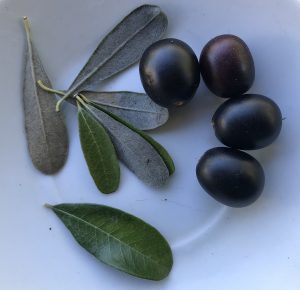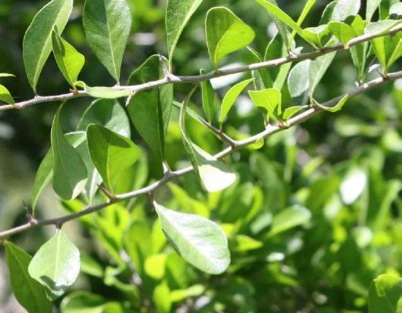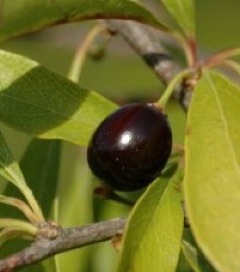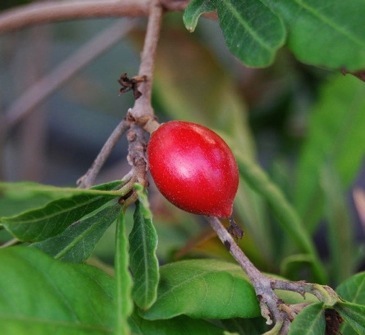Sideroxylon: Chewy Ironwood
The Saffron Plum is not yellow or a plum, that is, it is not in the genus Prunus. And it is called a Buckthorn but it isn’t one of those either. And I learned it as a Bumelia, but sometime between 1996 and 1998 it became a Sideroxylon…Ya just got to love botanists and their penchants for changing plant names.
In all fairness, Bumelia is not accurate for the species. It means “European Ash” and most of the trees in the genus do not really look like the ashes at all. Sideroxylon is better but not without issue. That means, in mispronounced Greek, Iron Wood. That is a common term for the Carpinus genus. But Sideroxylon it is. (In Greek the word for railroad, σιδηρόδρομος, sidirodromos, means iron road.)
This species is another fruiting tree that sits on the cusp of edible, some Sideroxylon species have just edible berries and some species have just unedible berries. Nine are commonly mentioned as edible, or chewable at least: S. celastrina, S. foetidissimum, S. laetevirens, S. lanuginosa, S. lyciodes, S. reclinatum S. salicifolium, and S. tenax. The S. tenax is rather rare in the wild but a native landscape plant. One used to live not 2.5 miles west from me where the land abutted an overpass over Interstate 4. A road crew dutifully took it down and the road since widened. However, I recently spotted one inside a locked cemetery about a mile east of me.

The fruit and leaves of a Sideroyxlon but which one? Photo by Green Deane
The ninth Sideroxylon received a lot attention in the 1970s and has occasioal revivials, the Sideroxylon dulcificum. (now called in 2020 Synsepalum dulcificum.) You may not recognize the name but if you eat the berries — the Miracle Berry — for about a half an hour afterwards you cannot taste anything sour. You can eat a lemon after the berries and the lemon will taste sweet. It also counters a metallic taste some experience while undergoing chemotherapy. The ability of the berries to alter taste perception was noted as early as 1725. It was touted as a possible “sweetener” in the 70’s and the role of the sugar industry — if any — in its demise is controversial. Tablets of the berries can be bought over the Internet. How they work is not known but one theory is that it temporarily alters the physical shape of the taste receptors on the tongue.
Sideroxylons have several traits in common, which means you can at least identify the genus. The species is the next challenge. They all produce a milky sap, all have simple leaves without lobes or teeth, and the leaves alternate along the stem. The leaves are usually small, dark green, and rounded to elliptical. The Sideroxylons are nearly evergreen, dropping leaves late and putting on a new crop almost immediately. Like Hawthorns they branch irregularly giving each plant “character.” Sideroxylons develop short unhooked thorns that are not aggressive. Their flowers are small and white sometimes greenish white, some are attractive and some are aromatic. The fruit is dark purple, egg-shaped, oblong to round, juicy. The tree usually fruits heavily. (By the way they are all anti-inflammatory as well.)
The fruits of the S. foetidissimum and S. salicifolium are gummy and acidic — think eating it as gum rather than a fruit. They can stick your lips together. If you eat too many it can burn the lips of sensitive individuals. Sap from the S. Salicifolium has been used as gum. The Sideroxylon celastrina (sid-er-ROX-il-on see-LASS-trin-a) is the one most recommended because it has the largest and best fruit. It is a coastal hammock tree and is found mid-Florida south and in south Texas. It is also called in many publications and websites Bumelia celastrinum (Bew-MEE-lee-uh see-LASS-trin-a.) Celastrina is also mispronounced Greek meaning resembling the Celastrus, or the Bittersweet.
Green Deane’s “Itemized” Plant Profile
IDENTIFICATION: A coastal shrub or tree but found inland, thorny branches, leaves narrow oblong, or spatulate, one to one and a half inches long, smooth, sometimes spine tipped, often densely clustered along branches. The flower is tiny, white, five lobes, in axillary clusters (where stem and leaf meet) fragrant. Fruit oblong or cylindrical, 3/4 inch long, dark purple or black.
TIME OF YEAR: Almost year round
ENVIRONMENT: Hammocks
METHOD OF PREPARATION: Ripe fruit eaten raw, but not the seed.
Sideroxylon dulcificum




